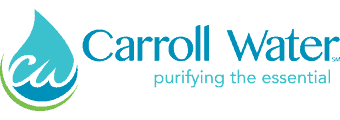Residents on public water systems (PWSs) often wonder, is my tap water safe to drink? At Carroll Water, we hear this question a lot from our residents in Virginia who want to ensure that they have the best drinking water quality. The process of chlorinating public drinking water has been used by public utilities for over a century now and is successful in restricting pathogens from reaching the home. In recent times, many PWSs switched from using chlorine to chloramine to remove bacteria and other harmful microorganisms in the water.

What is chloramine?
Chloramine is a chemical compound made by adding ammonia to chlorine according to the Virginia Department of Health. A PWS plant like those in Virginia and Washington D.C. will add Chloramine to drinking water to kill bacteria and microorganisms in the treatment plant and the distribution system. The Environmental Protection Agency (EPA) states, “More than one in five Americans use drinking water treated with chloramines.”
What are safe levels of chloramine in water?
Chloramine levels up to 4 milligrams per liter (mg/L) or 4 parts per million (ppm) are considered safe in drinking water. At these levels, harmful health effects are unlikely to occur according to the EPA. Studies by the CDC also report that using or drinking water that’s been disinfected through the use of chloramine does not cause harmful health effects and provides protection against waterborne disease outbreaks.
What are the benefits of chloramine?
Chloramine is less volatile than chlorine so it won’t evaporate quickly from the water which means it can provide longer-lasting protection from bacteria as the water travels through the water distribution system to the home. Chloramine also has much less reaction to organic compounds in water than chlorine which creates “by-product” chemicals that are potentially carcinogenic.
What are the cons of chloramine?
Even Though PWSs are using safe methods to sanitize water from pathogens, many residents will report nuisance effects like a chlorine taste and smell in their water or they may experience skin rashes and breathing problems depending on their sensitivity. Chloramine changes the chemical properties of the water (adding what the EPA calls “disinfection by-products”) which could cause corroding in lead or copper pipes and rubber gaskets used in plumbing. Additional steps to remove chloramine from water are also recommended for locations that use water for dialysis, aquariums, baking, and craft beer brewing.
Does your water supply contain chloramines?
The best way to determine if your pipes should be protected from chloramine damage is to verify with your public water supplier if they treat your water source with chloramine. It is very easy to discover since all PWSs are required to produce an annual water quality report. All levels of contaminants and what methods are used to address them will be outlined in the report, including information on how your water is disinfected and if chloramine is used.
What can I do to remove chloramine from my home water?
If you are concerned about the safety or taste of chloramine in your water or corrosion on your plumbing, you can consider a whole-home filtration system to remediate chloramine.
3 steps to remove chloramine
- Obtain the latest water report from your PWS provider. This will report the level of contaminants in our water and the level of chloramine in the water, which is most likely within EPA standards.
- Contact a water treatment expert like Carroll Water to review your water concerns. When your water consultant visits you can share the latest water report from your PWS provider. The consultant will also perform a free home water test to evaluate your water for all contaminant issues.
- There are a variety of water treatment systems available (water filters, refiners, softeners, etc.), however, the best option would include a refining system with chloramine reduction. Upon installation, you will enjoy the benefits of chloramine disinfection without the taste or smell and your home plumbing will be protected from corrosion.
Home water plans designed by experts
Carroll Water is the only dealer in the Virginia area that offers the EcoWater Water Refining System® with chloramine reduction that will resolve water issues by removing the excess calcium and magnesium from the water, and also provide a whole home water filtration that removes chlorine taste and odor without compromising water flow, and eliminates the need for additional filters and filter changes.
If you are concerned about the levels of chloramine in your drinking water at your home or business, contact us today so we can review your concerns. A free water test with immediate results will be completed so that your Carroll Waters consultant can design the best solution for your home.
Carroll Water is the exclusive authorized EcoWater dealer in Virginia, Maryland, and Pennsylvania.


